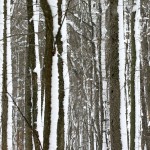Cheesequake State Park: Winter Bird Photography…with Climate Control
by Brett Klaproth, CWF volunteer photographer & wildlife advocate

What does Middlesex County’s Cheesequake State Park have over Cape May, Forsythe, Sandy Hook, the Great Swamp, and other more notable New Jersey birding sites? Reliably abundant and nearly effortlessly managed (Talkin’ to you there, Barnegat Light…) stellar winter photo ops. Plus heat.
Cheesequake is just 5 minutes off Garden State Parkway exit 120 and a 5 minute walk through the hardwood forest off its first parking lot reveals the park’s nature center. The building’s raised and roofed entrance deck sits before a small, lightly wooded area designated as a wildlife sanctuary and serves as a near ideal (Shadow issues (See wooded…).) shooting platform.
The center is operated and the sanctuary maintained by naturalist Jim Faczak, who has installed (soon to be upgraded) platform, jar, and commercial seed and suet feeders–the most active a mere 3 or so yards from the deck’s edge. Protected from hikers by split rail fencing and a steep decline across its far end, the location attracts a roster of favorite species, at times in dizzying (Almost fell once…) numbers, with most taking little issue (Aaand…there’s a titmouse on my lens…) with human observers.

The most prevalent–the aforementioned tufted titmouse and the Carolina chickadee and white-breasted nuthatch–frequently alternate positions on the platforms (Focus on the one on the right (Ha ha–focus (Never mind…).).), with the latter assuming dominance in the pecking order by virtue of its, well, yes, pecking. Red-bellied and downy woodpecker compete similarly at the suet cages with their
hairy cousins sometimes entering the rotation.
Dark-eyed junco scavenge below, and several resident Carolina wren (One lives in that house hanging off the corner of the building…) maneuver in intermittent shifts through low lying branches. Blue jay make their presence known vocally before venturing in, and a small group of more reserved mourning dove typically makes its way closer as afternoons progress.

Northern cardinal, song sparrow, and brown creeper are occasional visitors, with others including American crow, American goldfinch, American robin, hermit thrush, American tree sparrow, and fox sparrow observed during more brief and isolated periods. Though rarities are aptly uncommon, there are also no invasives with which to contend, unless we define the term differently and include the occasional hawk.
Red-tailed, Cooper’s, and sharp-shinned all check for status updates, mostly via flyover. Strikes occur extremely rarely. The raptors’ mere appearances though, elicit an instant freezing (as in assuming a motionless position–not in an it’s 30 degrees in the shade and I forgot the Under Armour kind of way) among the smaller birds, creating a silent and somewhat surreal spectacle.
On the plus side of contending with 30 degree temperatures, though choosing a sunny day is most advantageous, shooting here after or even during (See roofed…) a snowfall makes for a sublime photographic experience. The forest itself provides a kind of magical (That’s right, going with magical.) setting when coated in white. And the ground being blanketed not only encourages increased activity at manmade food stations but provides images with added beauty and character as well as enhanced lighting (See shadow issues (Maybe see wooded again if necessary…)…).
With a slight increase in temperature, titmouse and chickadee cling to icicles, drinking droplets as they form. And for those without prejudice, deer can often be easily spotted under these conditions throughout the park. This might be of worthwhile if secondary interest as the sanctuary of course loses the light before do Cheesequake’s many fields.

The nature center is typically open from 8-4 Wednesday through Sunday. Calling in advance is advisable if one wants to be assured of immediate access to bathroom facilities and escapes from the cold (and a hand dryer which, okay, odd, but for the warmth provided a photographer would likely eventually share my appreciation).
Food might not be present at all times but Jim is giving readers permission to bring and distribute seed (Be sure there’s sunflower in the mix.) and suet to insure activity. Results are typically swift and satisfying.
And oh yeah, nuts. Offering peanuts will garner immediate popularity with certain (upwards of two dozen) bushy-tailed residents. If not looking to make friends nor prone to begging-induced guilt (Just me?), indulging the squirrels will also help keep feeders clear for the more typically welcome feathered patrons. And dispensing on the previously recommended platform in particular will optimize results by bringing the most discriminating (blue jay, wren) and timid (red-bellied woodpecker) subjects closer.
Throw in lunch for yourself and a rewarding and unusually comfortable cold weather day at Cheesequake is virtually guaranteed. Just remember the Under Armour.
- Complete park information can be found at: http://www.nj.gov/dep/parksandforests/parks/cheesequake.html.
- Check out more of Brett’s photography on Flickr.
- You can reach Brett via email.
All photos were taken last winter with a handheld Canon 40D and 100-400mm f/4.5-5.6L IS. That’d be the author on deck with a tripod-mounted Canon 500mm f/4L IS this winter.
Discover more from Conserve Wildlife Foundation of NJ
Subscribe to get the latest posts sent to your email.
Leave a Comment
Brett, really awesome photography. Thanks for sharing it. K
‘preciated, Kevin.
The relative ease with which one can get shots like this at the location is why I chose to write the article.
But, I should have been more emphatic re: bringing food. My shots are the result of virtually always doing so.
Brett
Snow on the ground, first white-throated sparrow I’ve seen at the location, lots of juncos, enough blue jays to warrant needing a lot of nuts.
Comments are closed.